![]()
![]()
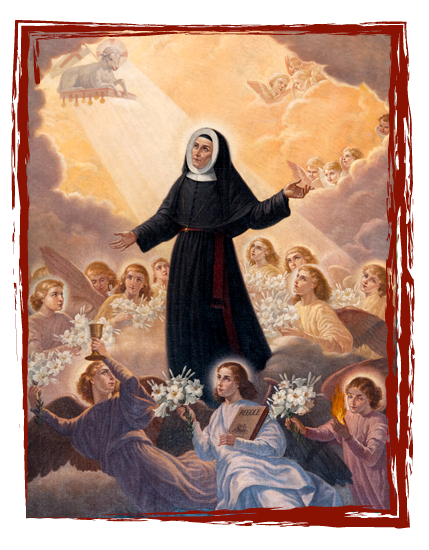 Maria De Mattias was born in Vallecorsa (FR) on February 4, 1805. Touched by the image of Jesus, the Immolated Lamb, after a profound experience of prayer and reflection, founded the Congregation of the Adorers of the Blood of Christ in 1834 in Acuto, a small mountain town close to Rome. She immediately began to go to various towns in central Italy and, with her first followers, began a religious community dedicated to evangelization, to promote the development of people through schools, catechesis, welcoming the very poor….
Maria De Mattias was born in Vallecorsa (FR) on February 4, 1805. Touched by the image of Jesus, the Immolated Lamb, after a profound experience of prayer and reflection, founded the Congregation of the Adorers of the Blood of Christ in 1834 in Acuto, a small mountain town close to Rome. She immediately began to go to various towns in central Italy and, with her first followers, began a religious community dedicated to evangelization, to promote the development of people through schools, catechesis, welcoming the very poor….
Maria knew how to embrace every suffering and difficulty with an open spirit and was also ready to give her life for “the dear neighbor.” Formed in a knowledge of Jesus Christ and in mystical experience, she led the men and women to whom she preached, often in churches and sometimes in the main squares of the small towns, by amazing everyone and making them enthusiastic.
During her lifetime she wrote thousands of letters addressed to her sisters, the bishops and political leaders. They reflect the wisdom of her soul and her feminine sensitivities, as well as her deep inner richness (Maria De Mattias, Letters, compiled by Angela Di Spirito and Luciana Coluzzi, Rome, 2005 , volumes 1-5.)
This human and spiritual inheritance is still the source of inspiration and nourishment for the Adorers of the Blood of Christ and for others who go to this precious literature.
Maria De Mattias died in Rome on August 20, 1866. On October 1, 1950 Pius XII declared her Blessed.
On May 18, 2003, John Paul II recognized her holiness and declared her a saint.
Today about 1,300 Adorers work on all the inhabited continents by continuing the work of the Foundress in various apostolic ministries with a spirit of self-giving and self-sacrifice.![]()
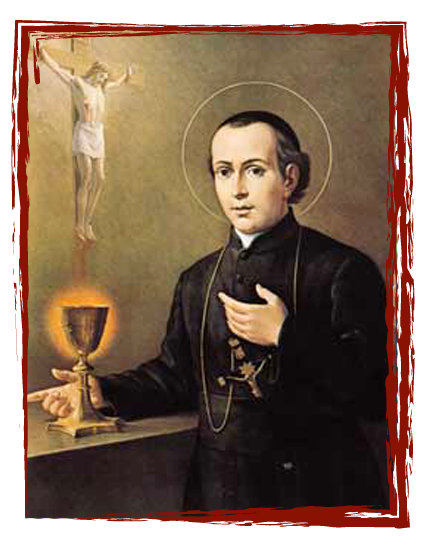
Ordained a priest on July 31, 1808, Gaspar intensified his apostolate among the popular classes by founding the first oratory in Santa Maria in Pincis and by being specialized in the evangelization of the “barozzari”, horse-drawn vehicle drivers and peasants of the Roman countryside who stored their hay in the Roman Forum called at that time the Cow Field. It was a difficult time for the Church. During the night between July 5th and 6th, 1809, Pius VII was made a prisoner and was deported. On June 13, 1810 Gaspar refused to swear allegiance to Napoleon and was condemned to exile and then to jail, which he serenely endured for four years. Upon returning to Rome in the first months of 1814 after the fall of Napoleon, he put his strength and his life at the service of the pope. Pius VII gave him the orders to dedicate himself to popular missions to restore religious and moral order.
![]()
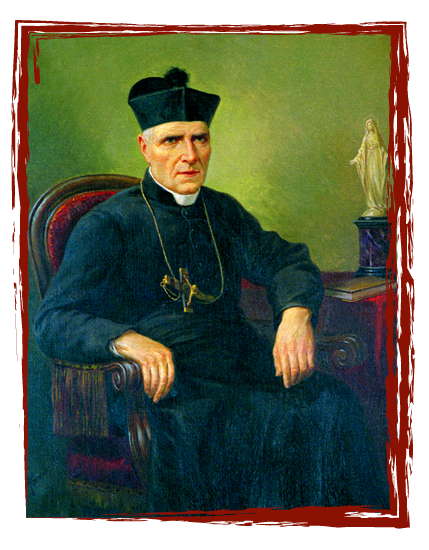 John Merlini was born in Spoleto on August 28, 1795, to a pastry-maker of distant Messina origins and a very religious Umbrian woman, who, in deference to her husband’s wishes, lived a very retired life. The boy Merlini understood that he should be a priest and became one, overcoming the resistance of his father who saw him as the ideal man to continue the family lineage and the family business.
John Merlini was born in Spoleto on August 28, 1795, to a pastry-maker of distant Messina origins and a very religious Umbrian woman, who, in deference to her husband’s wishes, lived a very retired life. The boy Merlini understood that he should be a priest and became one, overcoming the resistance of his father who saw him as the ideal man to continue the family lineage and the family business.
After Merlini became a priest he understood that it was the beginning of a new path to become more and more a priest, more and more the image of Christ. At that moment he understood he had to be a sure guide for the young men in the junior high school because the bishop had entrusted them to him.
To be a better educator Merlini decided to go to San Felice di Giano, where he had learned that the famous Roman missionary Gaspar Del Bufalo would conduct a retreat for the clergy of the diocese. Giano, more precisely the Abbey of San Felice, was the place where a House of Mission had been functioning for five years. Its opening had marked the beginning of the Congregation of the Missionaries of the Most Precious Blood. Merlini went there with a companion priest. For both of them it was an encounter of a lifetime.
During the retreat at San Felice, the plans of the two priests of Spoleto underwent a spiritual upheaval. At different times, they both had become Missionaries. Especially John Merlini, had a fundamental role in the organization of the Congregation of the Missionaries of the Most Precious Blood because Father Gaspar, continually moving from town to town, passed all the thorny questions on to Father Merlini.
Having been contacted by Maria De Mattias from Vallecorsa on the day after the mission preached by Gaspar, Fr. Merlini began directing her with loving meticulousness. This was the same way he entered into all the problems of the newborn institute of the Adorers of the Blood of Christ until Maria’s death.
He was so sought after and loved by the people that even Pope Pius IX, who admired his virtue, often asked him for his advice. In 1849, listening to the Father John’s ardent supplication, the Pope extended the feast of the Most Precious Blood of Jesus to the entire Church. He died after being run over by a stage coach on purpose on January 12, 1873 in Rome. Father John’s last good action was that of forgiving the stage coach driver who had run over him.
His earthly remains, lie next to those of his teacher, St. Gaspar, in the Church of St. Maria in Trivio (next to the Trevi Fountain) in Rome.
The Church has declared John Merlini’s virtues heroic and honors him among the venerable.
According to the canonical procedure the cause of Beatification and Canonization of the Venerable Giovanni Merlini was officially reopened last May, because of the case of alleged recovery occurred in Benevento (Italy) which is attributed to his intercession.![]()
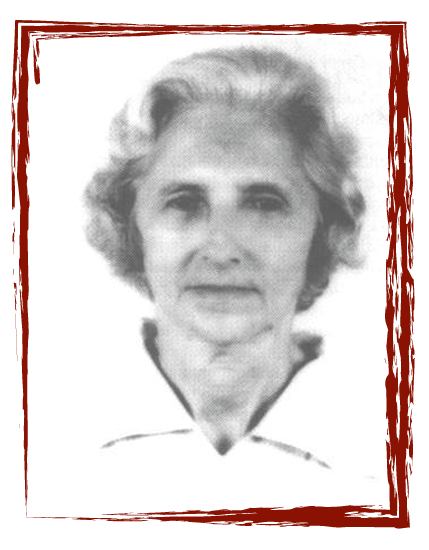
Serafina Cinque, given the name Noemi at baptism, was born January 31, 1913 in Boca das Garças, a village on the Amazon River (Brazil), to parents of Italian descent (from Sapri in the Salerno region). She was the second of twelve children and was very protected and a bit “spoiled” because of her precarious health.
When she was eleven her strict father entrusted her to the Dorothean sisters in Manaus to teach and educate her. The sisters prepared her for her First Communion and on this day she unexpectedly decided she would give her life completely to Jesus. Her parents would not allow her to join the convent immediately.
Instead, she worked hard as a catechist of children, youth and adults in her parish in Manaus. In order to help the sick poor people, she also earned her diploma in nursing. In 1946, at the age of 33, Noemi joined the Sisters Adorers of the Blood of Christ who, having come from the United States, had opened a mission in the Amazon.
The poverty surrounding her deeply touched her heart and would not allow her to close her eyes to it. Rather, she worked tirelessly for the poor. She urged the young boys and girls to study in order to have a better future. She rushed to the bedsides of mothers in childbirth to save both mothers and the babies. She welcomed all kinds of sick people and took care of them with medicines that she often prepared herself. And, above all, she prepared other people to help and continue her work.
In 1972, the year the Transamazonian highway was begun and many of Brazil’s poor were attracted to the area. Sr. Serafina was sent to Altamira, a town in the heart of the forest, to teach in the evening section of the Maria De Mattias Institute and to direct the diocesan clinic. Here Sr. Serafina came into even more direct contact with the great plight of the people as a result of the difficulties the Transamazonian highway added to their pre-existing poverty. She did everything she could to help the pregnant women, coming from the forests to the city, to give birth to their children. Many had no place to stay and no one to help them. She also welcomed to the clinic the sick coming from the interior. Her gentle insistence with Bishop Erick Kraűtler, already sensitive to the problems of these women, brought about the construction of a home to meet their needs. Sr. Serafina called it the Divine Providence Home because it would have to be maintained by the generosity of the people of the city of Altamira and the peasants of the forest. In 1984 the Divine Providence Home for the pregnant women was built and the St. Gaspar Refuge for the sick was built shortly after. Soon there were 100 patients in the two. And Sr. Serafina would go begging for them every day, going door to door. She experienced “how good God is,” an expression that became her motto. She was called “Mother Teresa of Altamira.” Because of this, the national press also called her the “White Angel of the Transamazonian Highway.” However, the purpose of Sr. Serafina’s work was not only health care assistance but also the psychological, social, cultural and religious formation of the guests in the Divine Providence House. She helped with their immediate needs but she was also concerned about the future of the people. She helped them to have a life of dignity and to become self-supporting. Sr. Serafina was diagnosed with lymphoma and died in Manaus on October 21, 1988. The process of her canonization has been begun and the Church declared her venerable in January, 2014.![]()
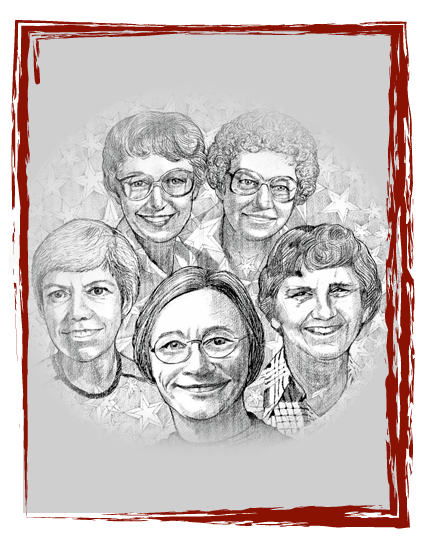
This is the story of Sisters M. Joel and Shirley Kolmer, Agnes Mueller, Barbara Ann Muttra, Kathleen McGuire, “martyrs of charity” in Liberia, Africa. These Adorers from the United States Ruma Province showed what it means to be attentive to the “dear neighbor” to the very end.
Through the years in Liberia, the “dear neighbor” made his/her appearance in the students asking questions, in the refugees who were victims of terror, in the suffering patients and in the rejected orphans. The Sisters took care of everyone in the school classrooms and in the distribution centers for various types of assistance. As the civil war in Liberia begun by the conflict and proceeding out of control, which between October 20-23, 1992, would mow down their completely given existence, they comforted and distributed cups of fresh water to the “dear neighbor” who painfully walked and stumbled by their home in Gardnersville outside Monrovia, in a procession of refugees fleeing the conflict.
In one of the smallest and most developmentally-challenged African nations, the Sisters had opened parochial schools to educate the poor children. They established clinics to take care of emergencies, treat malaria and other diseases, and eliminate malnutrition. They had not hesitated to go to the very poor villages to treat the sick and provide medications and to begin schools.
The beginnings had not been easy. They had to face the lack of potable water, the annoyance created by many tropical insects, the phenomenon of “thieves” who engaged in continual and systematic raids on their houses, school and clinics. They had had to fight malaria and hepatitis which weakened their physical health.
But nothing had stopped them. Moreover, it seemed that the difficulties stimulated enthusiasm and creativity. When they found themselves in the middle of the civil-war whirlwind with its hatred, thefts and killings, they did not think of themselves or their safety. Rather these five committed women, though very different among themselves, were united by the one same “readiness” to serve the broken people and to give themselves totally.
Two of them were killed while going in a jeep to help a sick person. The other three were shot down in their convent compound.
Pope John Paul II, in referring to their sacrifice, called them martyrs of charity.
![]()
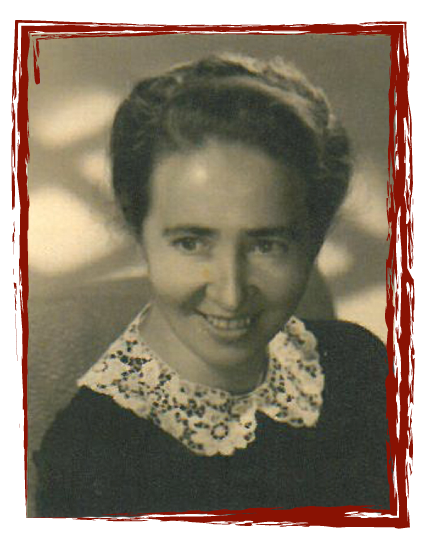
Josipa Nevistić was born on March 8, 1907, in Bosanska Gradiška to Ivo and Katica Nevistić. She pronounced her first vows on August 15, 1926, and her perpetual vows on August 15, 1931. She worked as a school teacher.
On April 18, 1944, during the worst of the horrors of WWII, she left the Congregation with a dispensation from her vows by the diocesan bishop, Canon 81.
After having left the community, Josipa lived with a family in Ruševo (near Slovonska Požega) and worked in the parish.
According to various testimonies gathered some years after her death, she taught catechism to children and worked with youth and adults.
The locals always considered her a Sister and were bound to her by great esteem and affection.
At the end of the war, with the advent of communism, a period of persecution of the Church began in the already battered land.
Sister Josipa was put in prison. After being released from prison, she went back to Ruševo and was taken, abused and killed. The exact day she was killed is not known, but it was at the beginning of the month of October in 1946. For various years, the people did not talk about the event, because of fear, and they did not know where she had been buried. A few years later, her body was found near a river and was taken to the cemetery. All this was secretly done.
No sign of recognition was put on her tomb in order to prevent her body from being found again and be further vilified.
From various testimonies gathered after the fall of communism during the nineties, much news was found out, even detailed information that show how much good she did and how much the people loved her. Various newspaper articles have been published in recent years recounting the life and death of Sr. Josipa. Her name was reported in the monographies of the Croatian martyrs of the Second World War.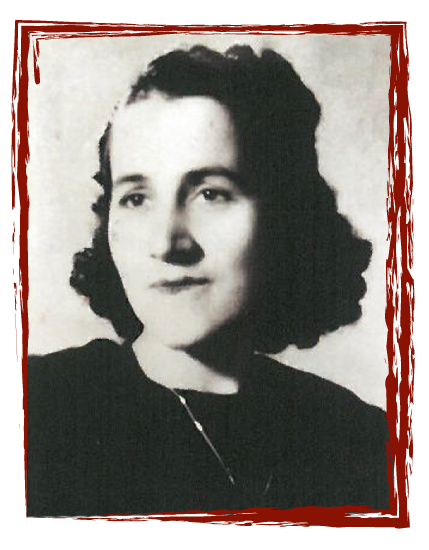
Eulalija Kulier was born on February 10, 1910, in Fojnica to Aleksa and Jozefina Kulier.
She pronounced her first vows on August 15, 1929, and her perpetual vows on August 18, 1934.
In 1946, after WWII when the communists expropriated all the schools and houses of the Sisters, Eulalija, like many other Sisters, went in search of a place to live and a job in order to survive.
Together with Josipa Nevistić she stayed in Croatia in the area of Slavonska Požega and lived and worked in Pleternica. She taught and played the organ.
She was abused and killed on March 1, 1947, and her body was thrown in the Orljava river
The testimonies gathered recount that before killing her they cut off her fingers, mockingly asking her to play the organ.
After the snow melted, her mangled body was found on March 25 and was buried in the cemetery.
Sharing not only the ASC charism but also persecution and a violent death, these two Sisters of ours have always been considered martyrs of faith by the local people.
It is important to underline that their memories have remained alive in the people, especially that of Josipa, in spite of the prohibition to speak about people who disappeared, something considered a crime, punishable by death.
The whole story came to light only after 1990.![]()
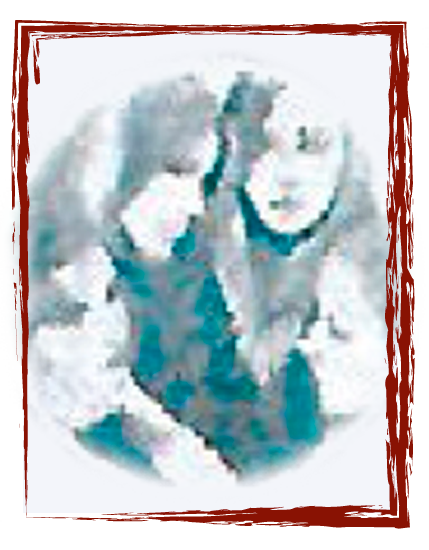
Teresa Francesca was born in Ceccano (FR) on November 27, 1817, the first born of the children of Dr. Gioacchino and Maria (Valenti) De Sanctis.
She met MDM for the first time in November 1840 when Maria made a stop Maria in Patrica during her travels to Vallecorsa where she was going to open the school. Upon Maria’s return to Acuto, Teresa along with her sister Carolina followed her. She made her profession on November 1, 1857. A woman with a contemplative temperament, she loved the Institute very much and fully absorbed its charism. Because of her abilities, she was charged with opening various new communities: Pescasseroli, Morino, Sgurgola, St. Giovanni in Rome, Piglio, Narni ….. Teresa accompanied MDM in her last missionary trip to Capranica and remained near her until Maria’s death. She was a general councilor of Carolina Signoretti. Her love for MDM and faithfulness to the charism put her in conflict with the ecclesial authorities who wanted the profession of perpetual vows for the Institute. Neither Teresa nor her sisters Carolina and Rosa knew how to accept this decision, preferring separation to that. It was certainly a sad page of history, but that takes nothing from the stature of the faithful and convinced follower of MDM.
She died in Rome on July 27, 1896, in a dwelling on Via Muratte, 70.
How is it that her name does not appear in the necrology of the deceased Adorers? It is a painful and sad page of history.
The Congregation of the Adorers developed without vows.
In 1878, twelve years after the death of the Foundress, a decree was pronounced by the Sacred Congregation of Bishops and Regulars granting the long-awaited approval of the Institute, but at the same time it demanded the profession of vows.
A serious problem arose. With the introduction of the vows, could the Institute say it was the same one founded in Acuto in 1834?
All of the general council, made up of Carolina Signoretti as general superior, and Carolina and Teresa De Sanctis as councilors, were against the innovation. Carolina Signoretti was invited to resign of her own accord by the Sacred Congregation, and she did so.
The new general superior, Sister Caterina Pavoni, even though she was also against the vows, seeing that the thing was to be done, assumed the office with the precise intent of resolving the problem in the way the Sacred Congregation wanted. A deep break was verified in the Institute and the De Sanctis sisters were at the head of the “rebels.”
Caterina Pavoni was an excellent Sister, for her moral exactitude as well as for her abilities to command. She went straight forward without hesitation. The De Sanctis sisters were no less, neither on the moral plan nor in terms of firmness of character. They were supported by almost all the older Italian Sisters in being against the vows. Teresa and Carolina had already entered the Institute when Caterina Pavoni was born! It was difficult to appeal to tradition with them or pretend to teach them what the foundress had intended to do. One could certainly appeal to ecclesial authorities, but how many times had Maria De Mattias had to insist and resist with bishops and cardinals? Moreover, the cardinal vicar was on the side of the De Sanctis sisters.
These facts form a painful chapter of ideal controversy and brawl. In the face of episodes of that kind, which see very dignified and sincere people on opposing sides, one is really left baffled.
Unfortunately, the conditions given by the Sacred Congregation left no loopholes. The recalcitrant Sisters found themselves facing the dilemma of total surrender or expulsion.
The dissenting Sisters were divested of the house on Via degli Avignonesi and forced to change their name and habit. They were called the Daughters of the Divine Blood.
An old project, which had never been completely abandoned, was taken up again – fusion with the institute in Patrica, which also did not have vows. After a few years of negotiations, the idea of reunion began to grow. The request to be “re-admitted” was put forward, and the general administration accepted it on January 11, 1906. In the meantime, Teresa De Sanctis had died, and she was the only one of the three evangelists whose name did not end up in the necrology of the deceased Adorers.
What a sad fate and, and let’s face it, unjust for one of the most worthy followers of Maria De Mattias. Defined by the same foundress “woman of great spirit,” she confirmed that status to the end.
Unjust fate, because no one more than she had shouted out enthusiasm for being in the Institute! No one had defended the growing work with bolder courage. In her famous letter to her father, which she wrote to repudiate him, she showed she was equal to St. Francis of Assisi, whose name she bore. “I have given myself to the Institute forever!” she had cried.
And yet, those who skim through the pages of the Adorers’ necrology, do not find her!
This memory intends to return her to that institute which she loved so much, and to point her out to its followers as a shining example to follow.
